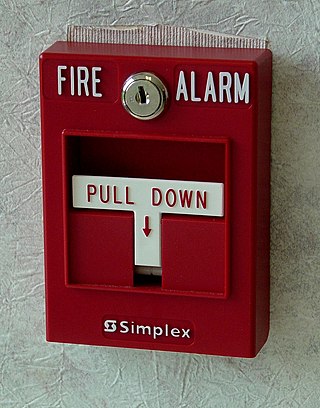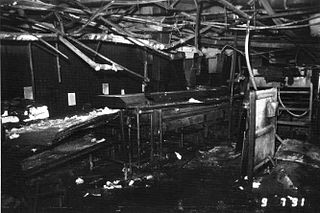
Locksmithing is the science and art of making and defeating locks. Locksmithing is a traditional trade and in many countries requires completion of an apprenticeship. The level of formal education legally required varies from country to country from none at all, to a simple training certificate awarded by an employer, to a full diploma from an engineering college, in addition to time spent working as an apprentice.
Trusted Computing (TC) is a technology developed and promoted by the Trusted Computing Group. The term is taken from the field of trusted systems and has a specialized meaning that is distinct from the field of confidential computing. With Trusted Computing, the computer will consistently behave in expected ways, and those behaviors will be enforced by computer hardware and software. Enforcing this behavior is achieved by loading the hardware with a unique encryption key that is inaccessible to the rest of the system and the owner.

Physical security describes security measures that are designed to deny unauthorized access to facilities, equipment, and resources and to protect personnel and property from damage or harm. Physical security involves the use of multiple layers of interdependent systems that can include CCTV surveillance, security guards, protective barriers, locks, access control, perimeter intrusion detection, deterrent systems, fire protection, and other systems designed to protect persons and property.

A firefighter is a first responder trained in firefighting, primarily to control and extinguish fires that threaten life and property, as well as to rescue persons from confinement or dangerous situations. Male firefighters are sometimes referred to as firemen.

A fire engine, firetruck, or fire ambulance is a vehicle, usually a specially-designed or modified truck, that functions as a firefighting apparatus. The primary purposes of a fire engine include transporting firefighters and water to an incident as well as carrying equipment for firefighting operations in a fire drill. Some fire engines have specialized functions, such as wildfire suppression and aircraft rescue and firefighting, and may also carry equipment for technical rescue.

A fire department or fire brigade, also known as a fire company, fire authority, fire district, fire and rescue, or fire service in some areas, is an organization that provides fire prevention and fire suppression services as well as other rescue services.

A safe is a secure lockable enclosure used for securing valuable objects against theft or fire. A safe is usually a hollow cuboid or cylinder, with one face being removable or hinged to form a door. The body and door may be cast from metal or formed out of plastic through blow molding. Bank teller safes typically are secured to the counter, have a slit opening for dropping valuables into the safe without opening it, and a time-delay combination lock to foil thieves. One significant distinction between types of safes is whether the safe is secured to a wall or structure or if it can be moved around.

Firefighting is a profession aimed at controlling and extinguishing fire. A person who engages in firefighting is known as a firefighter or fireman. Firefighters typically undergo a high degree of technical training. This involves structural firefighting and wildland firefighting. Specialized training includes aircraft firefighting, shipboard firefighting, aerial firefighting, maritime firefighting, and proximity firefighting.
Firefighting jargon includes a diverse lexicon of both common and idiosyncratic terms. One problem that exists in trying to create a list such as this is that much of the terminology used by a particular department is specifically defined in their particular standing operating procedures, such that two departments may have completely different terms for the same thing. For example, depending on whom one asks, a safety team may be referred to as a standby, a RIT or RIG or RIC, or a FAST. Furthermore, a department may change a definition within its SOP, such that one year it may be RIT, and the next RIG or RIC.
This is a glossary of firefighting equipment.

Manual fire alarm activation is the process of triggering a fire alarm through a call point, pull station, or other device. This usually causes the alarm to sound the evacuation signal for the relevant building or zone. Manual fire alarm activation requires human intervention, as distinct from automatic fire alarm activation such as that provided through the use of heat detectors and smoke detectors. It is, however, possible for call points/pull stations to be used in conjunction with automatic detection as part of the overall fire detection and alarm system. Systems in completed buildings tend to be wired in and include a control panel. Wireless activators are common during construction.

An electronic lock is a locking device which operates by means of electric current. Electric locks are sometimes stand-alone with an electronic control assembly mounted directly to the lock. Electric locks may be connected to an access control system, the advantages of which include: key control, where keys can be added and removed without re-keying the lock cylinder; fine access control, where time and place are factors; and transaction logging, where activity is recorded. Electronic locks can also be remotely monitored and controlled, both to lock and to unlock.

A fire alarm box, fire alarm call box, or fire alarm pull box is a device used for notifying a fire department of a fire or a fire alarm activation. Typically installed on street corners or on the outside of commercial buildings in urban areas, they were the main means of summoning firefighters before the general availability of telephones. Fire Alarm Call Boxes are still widely used in many cities and towns.

On September 3, 1991, an industrial fire caused by a failed improvised repair to a hydraulic line destroyed the Imperial Food Products chicken processing plant in Hamlet, North Carolina. Despite three previous fires in 11 years of operation, the plant had never received a safety inspection. The fire killed 25 people and injured 54, many of whom were unable to escape due to locked exits. It was the second deadliest industrial disaster in North Carolina's history.

The Boston Fire Department provides fire services and first responder emergency medical services to the city of Boston, Massachusetts. It also responds to such incidents as motor vehicle accidents, hazardous material spills, utility mishaps, floods, explosions, and construction accidents among others.
In the United Kingdom and Ireland, a retained firefighter, also known as an RDS firefighter or on-call firefighter, is a firefighter who does not work on a fire station full-time but is paid to spend long periods of time on call to respond to emergencies through the Retained Duty System. Many have full-time jobs outside of the fire service. Retained firefighters are employed and trained by the local fire and rescue service.

Firefighting in the United States dates back to the earliest European colonies in the Americas. Early firefighters were simply community members who would respond to neighborhood fires with buckets. The first dedicated volunteer fire brigade was established in 1736 in Philadelphia. These volunteer companies were often paid by insurance companies in return for protecting their clients.

A real-estate lock box is a padlock-shaped box that generally hangs around the doorknob of a house that is on the market. The device holds the keys to a house to allow communal access for all real estate agents, while continuing to keep them secure. Permission is generally required from the seller, who is the owner, to install such a device on the door. Lock boxes can also be used for the general storage and security of keys for the use of familial access.
Samsung Knox is a proprietary security and management framework pre-installed on most Samsung mobile devices. Its primary purpose is to provide organizations with a toolset for managing work devices, such as employee mobile phones or interactive kiosks. Samsung Galaxy hardware, as well as software such as Secure Folder and Samsung Wallet, make use of the Knox framework.
A lockbox or lock box refers to a box, container or otherwise enclosed space with a built-in lock. Examples include:















